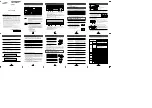
•
•
•
•
•
•
•
•
•
•
•
Op-
tion
Name
Description
used. If an incremental feedback device is selected, the drive automatically adjusts the motor angle offset
on the 1
st
start after power-up, or when the motor data is changed.
[1]
Auto
The drive adjusts the motor angle offset automatically on the 1
st
start after power-up, or when the motor
data is changed no matter what feedback device is selected. This means that the options
[1] Manual
and
[2]
Auto
are identical for the incremental encoder.
[2]
Auto ev-
ery start
The drive adjusts the motor angle offset automatically on every start, or when the motor data is changed.
[3]
Off
Selecting this option turns the automatic offset adjustment off.
[4]
Once with
store
This option updates
parameter 1-41 Motor Angle Offset
automatically when the angle value is 0. This option
is valid only for absolute feedback devices. The function uses rotor detection and then applies DC hold to
make the offset adjustment more accurate.
4.2.2 Motor Set-ups
4.2.2.1 Asynchronous Motor Set-up
Enter the following motor data. Find the information on the motor nameplate.
Parameter 1-20 Motor Power [kW] or parameter 1-21 Motor Power [HP].
Parameter 1-22 Motor Voltage.
Parameter 1-23 Motor Frequency.
Parameter 1-24 Motor Current.
Parameter 1-25 Motor Nominal Speed.
When running in flux control principle, or for optimum performance in VVC+ mode, extra motor data is required to set up the fol-
lowing parameters. Find the data in the motor datasheet (this data is typically not available on the motor nameplate). Run a com-
plete automatic motor adaptation (AMA) using
parameter 1-29 Automatic Motor Adaptation (AMA) [1] Enable Complete AMA
or enter
the parameters manually.
Parameter 1-36 Iron Loss Resistance (Rfe)
is always entered manually.
Parameter 1-30 Stator Resistance (Rs).
Parameter 1-31 Rotor Resistance (Rr).
Parameter 1-33 Stator Leakage Reactance (X1).
Parameter 1-34 Rotor Leakage Reactance (X2).
Parameter 1-35 Main Reactance (Xh).
Parameter 1-36 Iron Loss Resistance (Rfe).
Application-specific adjustment when running VVC+
VVC+ is the most robust control mode. In most situations, it provides optimum performance without further adjustments. Run a
complete AMA for best performance.
Application-specific adjustment when running flux
Flux control principle is the preferred control principle for optimum shaft performance in dynamic applications. Perform an AMA
since this control mode requires precise motor data. Depending on the application, further adjustments may be required.
See Table 3.3 for application-related recommendations.
Table 68: Recommendations for Flux Applications
Application
Settings
Low-inertia applica-
tions
Keep calculated values.
High-inertia appli-
cations
Parameter 1-66 Min. Current at Low Speed.
Increase current to a value between default and maximum de-
pending on the application. Set ramp times matching the application. Too fast ramp up causes an over-
current or overtorque. Too fast ramp down causes an overvoltage trip.
AU373327181955en-000101 / 130R1208 | 61
Danfoss A/S © 2021.08
Parameter Descriptions
VLT® AutomationDrive EZ FC 321
Programming Guide
















































